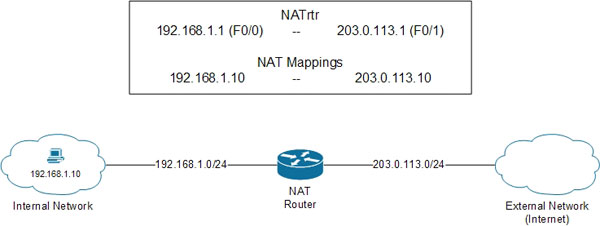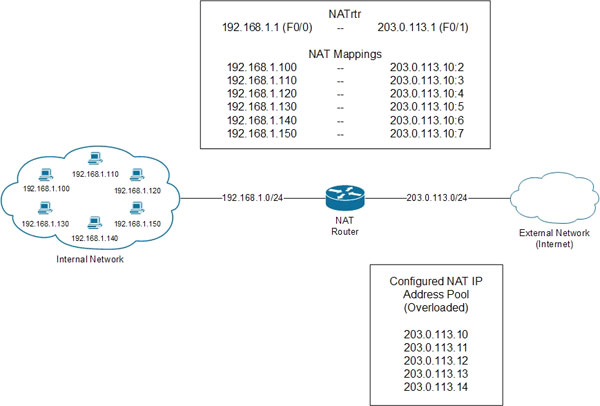Technical Network Address Translation (NAT)
TipsMake.com - Most people who own a modern Internet connection today must use NAT (Network Address Translation) technology. NAT has been an integral part of deploying a wide area IP network because the IPv4 address space has begun to shrink. Basically, NAT allows one (or more) local IP addresses to be mapped to one (or more) external IP addresses. This allows the use of a private IP address range based on RFC 1918 on local networks while using only one or a few public IP addresses.
The article will cover the basic concepts of NAT, types of NAT and how this technology works.
NAT
There are three different types of NAT: dynamic NAT, static NAT, and NAT overload (NAT overloaded).
With static NAT, an internal IP address specified will be mapped to a specified IP address other than the domain, as shown below.

In the image above, an internal network PC needs to communicate to another computer on the external network, in this case the Internet. But the RFC 1918 address is not capable of routing on the public Internet, so it cannot be used as a source or destination address. To handle this problem, NAT can be statically configured to connect the internal address 192.168.1.10 to the external address 203.0.113.10. Thus, for external networks, the incoming traffic will be from address 203.0.113.10 instead of 192.168.1.10. In this situation, NAT will treat the IP address 192.168.1.10 as the local address and the address mapped 203.0.113.10 as the internal address.
With dynamic NAT, the internal IP address is automatically matched to a set of external IP addresses. The mapping process is still between an internal address and an external address but occurs automatically.

In the above figure, the two PCs in the local network need to communicate to the machine on the external network, in this case the Internet. The NAT is dynamically configured to map internal addresses of 192.168.1.25 and 192.168.1.50 to IP addresses in the set of configured NAT addresses. In the figure, the machine has 192.168.1.50 address mapped to address 203.0.113.10 and the device has 192.168.1.25 address mapped to address 203.0.113.11. This means that the device with 192.168.1.50 address will be initialized first.
With NAT overloading (also called PAT port address compilation), mapping one as dynamic NAT and static NAT is not used. Instead of an external address assigned to only one internal IP address, it can now be assigned to all local machines based on the port number. Only when the number of available ports used by the external IP address is exhausted, can a second external IP address be used with the same method.

In the image above, there are six different machines accessing the external network. Overload NAT is configured with a collection of addresses in the range 203.0.113.10 to 203.0.113.14. Assuming that traffic passes through the NAT router sequentially, each type of traffic will be mapped to an external IP address (in this case the first IP address in range-203.0.113.10) and the specified port number. .
For each example, the NAT router configured to use the same IP address 192.168.1.1 on the Fast Ethernet interface 0/0 marked as internal NAT interface and 203.0.113.1 on the FastEthernet interface 0/1, is typed. The sign is an external NAT interface.
Conclude
There are many more complex methods for deploying NAT but the purpose of the article is to introduce NAT and how it works in simple examples. Hopefully the article has helped you better understand NAT and how it is used online.
You should read it
- What is static IP? What is dynamic IP? Distinguish between static IP and dynamic IP
- Set up the Linksys router with a static IP address
- What is a static IP address?
- How to Configure a Static Internet Protocol (IP) Address on a Computer
- What is an IP address?
- How to access IP address 192.168.100.1
- How to assign static IP addresses in Windows 7, 8, 10, XP or Vista
- 6 providers of the best free dynamic DNS
May be interested
- How to Change MAC Address on Windows
 sometimes you want to change the mac address of your network adapter. a mac address (media access control address) is a unique identifier used to identify your computer on a network. changing the mac address helps you diagnose network problems or change names. read step 1 below to learn how to change mac address on windows.
sometimes you want to change the mac address of your network adapter. a mac address (media access control address) is a unique identifier used to identify your computer on a network. changing the mac address helps you diagnose network problems or change names. read step 1 below to learn how to change mac address on windows. - Learn about NAT (Last part)
 the biggest benefit of nat is that network administration (network administation) is clear. for example, you can move your web server or ftp server to another host computer without worrying about broken links.
the biggest benefit of nat is that network administration (network administation) is clear. for example, you can move your web server or ftp server to another host computer without worrying about broken links. - Instructions for using IP address 192.168.2.2
 192.168.2.2 is a private ip address, sometimes used on local networks. this is the second ip address in the ip range starting from 192.168.2.1, sometimes called the 192.168.2.0 network.
192.168.2.2 is a private ip address, sometimes used on local networks. this is the second ip address in the ip range starting from 192.168.2.1, sometimes called the 192.168.2.0 network. - How to determine the device IP address on the local network
 before you begin to fix most network or internet connectivity problems, you need to know the ip address assigned to different hardware devices in your network.
before you begin to fix most network or internet connectivity problems, you need to know the ip address assigned to different hardware devices in your network. - Understanding IP address 192.168.1.4
 192.168.1.4 is the fourth ip address in the range from 192.168.1.1 to 192.168.1.255. home broadband routers often use this ip address to assign to local devices.
192.168.1.4 is the fourth ip address in the range from 192.168.1.1 to 192.168.1.255. home broadband routers often use this ip address to assign to local devices. - 6 ways to view IP addresses on computers, smartphones or Tablet
 when computers or other devices use the same local network, they send information to each other's ip address. if the new ip address is not located in the same network segment as the computer, the device is currently in use, the connection from the computer to the router will be interrupted.
when computers or other devices use the same local network, they send information to each other's ip address. if the new ip address is not located in the same network segment as the computer, the device is currently in use, the connection from the computer to the router will be interrupted. - How to Find Your IP Address on a Mac
 when your mac is connected to a network, it is assigned an address on the network called an ip address. the ip address is four sets of digits separated by periods, with up to three digits per set. if the mac is connected to a network as...
when your mac is connected to a network, it is assigned an address on the network called an ip address. the ip address is four sets of digits separated by periods, with up to three digits per set. if the mac is connected to a network as... - Translate English on the phone with quality translation apps
 the english translation application on the phone will help you can quickly translate all documents, understand the content without having to look up on the computer.
the english translation application on the phone will help you can quickly translate all documents, understand the content without having to look up on the computer. - How to view MAC address on Windows using Command Prompt
 along with the ip address, the mac address is used to identify network devices, helping to distribute data flows from the internet computer network to the device. so how to view the mac address on windows?
along with the ip address, the mac address is used to identify network devices, helping to distribute data flows from the internet computer network to the device. so how to view the mac address on windows? - How to fix IP 169 address error
 when you cannot connect to the internet and your computer seems to have an ip address starting with 169, the computer has an ip address error 169. this type of error occurs when a windows computer requests an ip address but does not receive.
when you cannot connect to the internet and your computer seems to have an ip address starting with 169, the computer has an ip address error 169. this type of error occurs when a windows computer requests an ip address but does not receive.










 Monitor Hyper-V with the command line (Part 4)
Monitor Hyper-V with the command line (Part 4) 10 new features in Windows Server 2012
10 new features in Windows Server 2012 Build your own simple NAS system for storage needs
Build your own simple NAS system for storage needs Build your own simple NAS system: Part 2: Installation
Build your own simple NAS system: Part 2: Installation Build your own simple NAS system, part 3: Basic storage configuration
Build your own simple NAS system, part 3: Basic storage configuration Yahoo! attacked, no damage
Yahoo! attacked, no damage